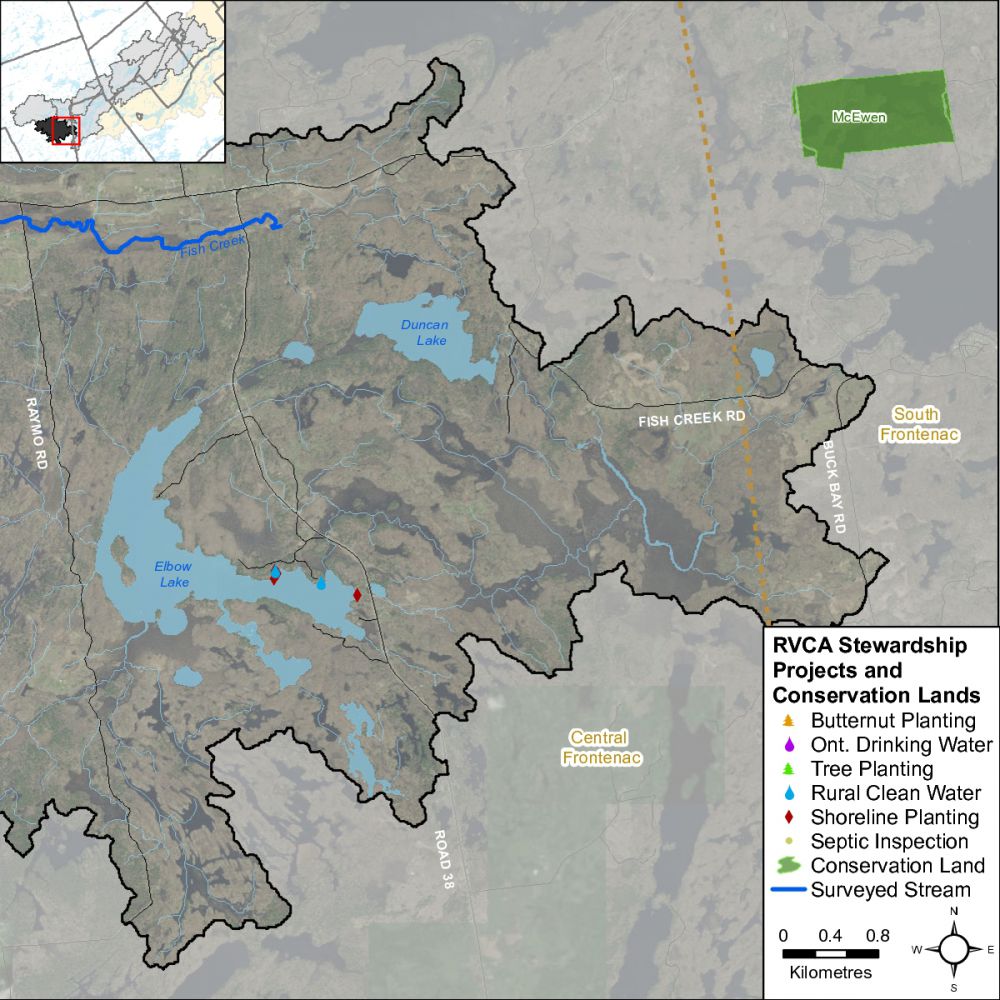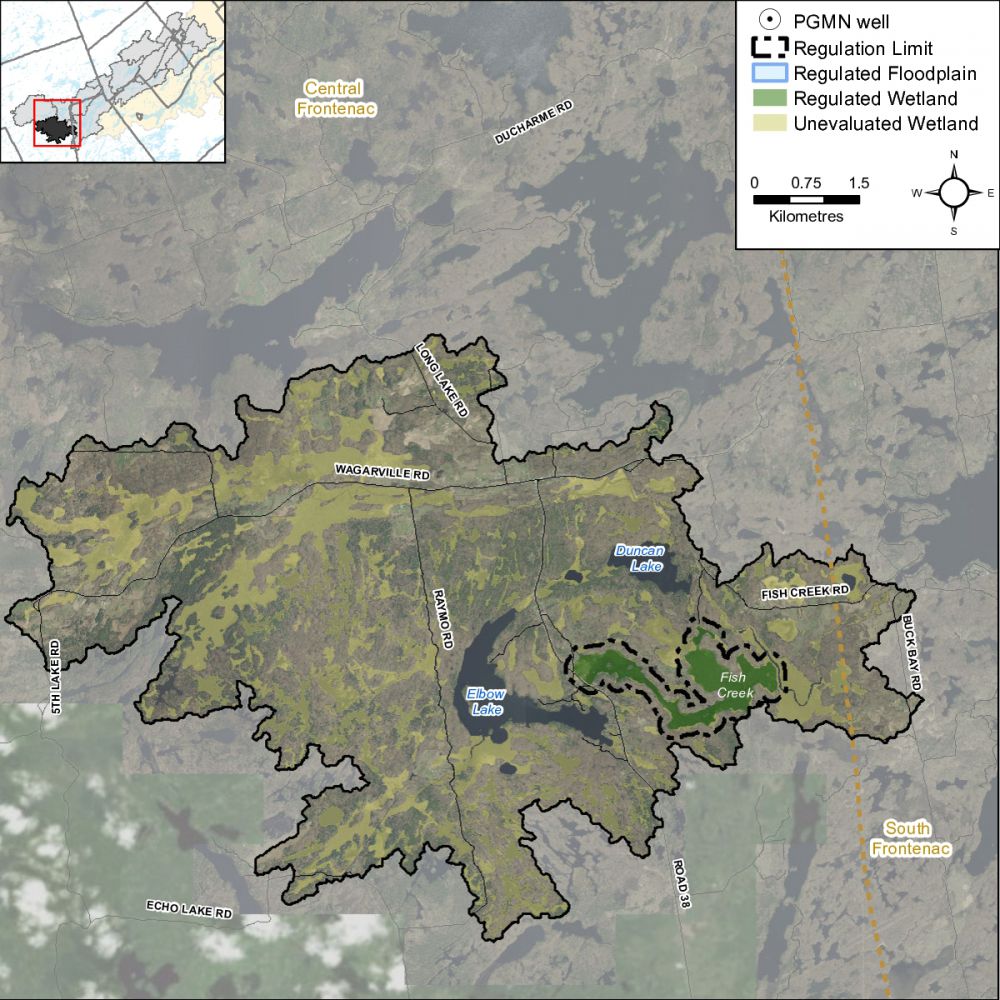5.0 Elbow Lake Catchment: Stewardship and Water Resources Protection
The RVCA and its partners are working to protect and enhance environmental conditions in the Tay River Watershed. Figure 66 shows the location of all stewardship projects completed in the Elbow Lake catchment.
5.1 Rural Clean Water
The Rural Clean Water Program provides technical and financial assistance to farmers and other rural landowners, to aid in the implementation of projects that protect water quality. Funding is granted to those projects that support best management practices for application in the protection and improvement of surface and ground water resources. The program also supports climate change adaptation and low impact development projects as well as educating rural landowners about environmental stewardship of private property. Examples of supported projects include livestock exclusion fencing, controlled tile drainage, cover crops, erosion control, well related projects, and many more. For a list of eligible projects and to apply for funding, see Rural Clean Water.
In the Elbow Lake catchment from 2011 to 2016, one windbreak/buffer and one education initiative were completed at a total value of $2,115.00 with $978.00 of that amount funded through grant dollars from the RVCA.
5.2 Private Land Forestry
Forest cover and tree planting continues to be one of the most widely supported strategies to improve our environment. The many benefits of forest cover include carbon sequestration, flood mitigation and water quality improvement as well as providing wildlife habitat. For more information about the Program and landowner eligibility, please see the following: Tree Planting in the Rideau Valley Watershed and Trees for Tomorrow.
5.3 Shoreline Naturalization
Natural shoreline buffers rich in native plants are critically important to protecting the health of our lakes, rivers and streams. Shoreline vegetation protects water quality and aquatic habitat by intercepting potentially harmful contaminants such as nutrients, pollutants and sediment, regulating water temperatures, slowing runoff and providing important fish and wildlife habitat. Natural shorelines also help improve climate change resiliency by increasing flood storage and providing protection from erosion during extreme weather events.
Though the RVCA's Shoreline Naturalization Program, landowners (private and public property owners) have naturalized more than 2.3 km of shoreline in the Tay Watershed by planting over 10,563 native trees and shrubs at 96 sites since 2008. In the Elbow Lake catchment, a total of 426 native trees and shrubs have been planted along 100 metres of shoreline at an average buffer width of five metres for a total project value of $4,834.00.
5.4 Fish and Wetland Habitat Improvement
With funding from the Ministry of Natural Resources, a group of volunteer from Elbow Lake hauled cobblestone onto the winter ice in order to improve the potential of the walleye spawning bed in the lake. This work was completed in 2013 and its success is to be determined using the results from a fish survey conducted by the Ministry of Natural Resources and Forestry in 2017.
5.5 Valley, Stream, Wetland and Hazard Lands
The Elbow Lake catchment covers 56 square kilometres with 2.5 square kilometres (or four percent) of the drainage area being within the regulation limit of Ontario Regulation 174/06 (Figure 67), giving protection to wetland areas and river or stream valleys that are affected by flooding and erosion hazards.
Wetlands occupy 15 square kilometres (or 27 percent) of the catchment. Of these wetlands, one square kilometre (or seven percent) is designated as provincially significant and included within the RVCA regulation limit. This leaves the remaining 14 sq. km (or 93 percent) of wetlands in the catchment outside the regulated area limit.
Of the 159.9 kilometres of stream in the catchment, regulation limit mapping has been plotted along 9.7 kilometers of streams (representing six percent of all streams in the catchment). Some of these regulated streams (6.9 km) flow through regulated wetlands; the remaining 2.8 kilometres of regulated streams are located outside of those wetlands. Plotting of the regulation limit on the remaining 150.2 kilometres (or 94 percent) of streams requires identification of flood and erosion hazards and valley systems.
Within those areas of the Elbow Lake catchment subject to the regulation (limit), efforts (have been made and) continue through RVCA planning and regulations input and review to manage the impact of development (and other land management practices) in areas where “natural hazards” are associated with rivers, streams, valley lands and wetlands. For areas beyond the regulation limit, protection of the catchment’s watercourses is only provided through the “alteration to waterways” provision of the regulation.
5.6 Vulnerable Drinking Water Areas
Mississippi-Rideau Source Water Protection Program has mapped the north boundary of the Elbow Lake catchment as a Significant Groundwater Recharge Areas and all of the catchment as a Highly Vulnerable Aquifer. This means that the nature of the overburden (thin soils, fractured bedrock) does not provide a high level of protection for the underlying groundwater making the aquifer more vulnerable to contaminants released on the surface. There are no Well-Head protection Areas in the catchment.
The Mississippi-Rideau Source Protection Plan includes policies that focus on the protection of groundwater region-wide due to the fact that most of the region, which encompasses the Mississippi and Rideau watersheds, is considered Highly Vulnerable Aquifer. For detailed maps and policies that have been developed to protect drinking water sources, visit the Mississippi-Rideau Source Protection Region website.

